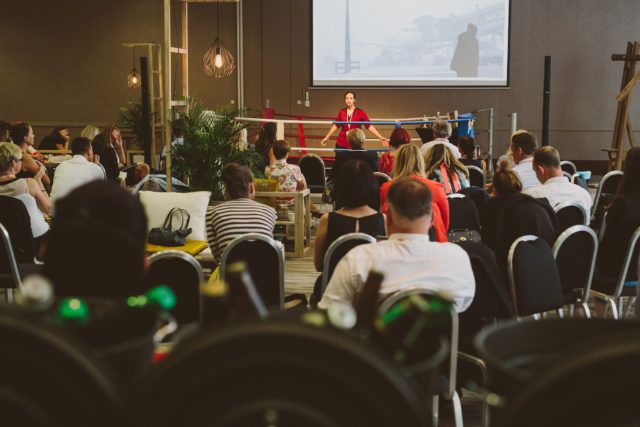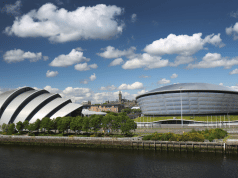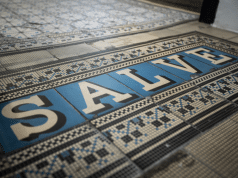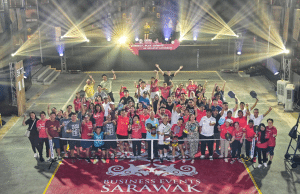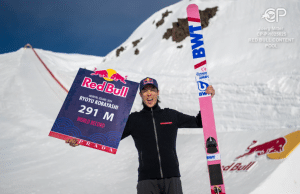THE STARTING POINT
To guarantee a great experience for your participants, you must first choose the right location. The main challenge here are the boring classic meeting halls. Today, event organisers have higher expectations, and in view of that, we strive to achieve radical changes with hotels, meeting centres, and other venues. To begin with, everybody involved in the meeting industry should adopt a designer-like way of thinking. This means that participants’ needs and emotions should always come first. In this, empathy and the ability to understand participants’ expectations and needs play a crucial role. It is of vital importance to find the answer to the question of how the participants will feel at our event.
THE CONCEPT
The crucial characteristic of event organisers is space sensibility. This entails the ability to sense a space and at the same time feel empathy. An event organiser must know how to listen, hear and understand participants’ expectations, thoughts and feelings. This is the only way that enables us to transform boring meeting halls into cosy living rooms – a space which is constantly transforming and is bursting with life. A place which enables cooperation, considering others’ views, understanding, and positive associations.
In order to achieve this, three conditions must be met regarding the transformation of meeting halls.
A stimulative atmosphere can be achieved with:
a view, lighting, colours, and a pleasant temperature. Too much or too little lighting may be disturbing. Most disturbing is direct white lighting. It is very important to maintain a constant temperature. Pleasant pastel colour combinations will add to a positive atmosphere, but the most important element is soft, appealing natural lighting.
An appealing atmosphere can be achieved with:
small details, eye-catching furniture, creative culinary spots, and ingenious lighting. You should enhance the space with something personal that tells a story. But don’t overdo it! Remember, less is more.
A socialising atmosphere can be achieved with:
an open, dynamic, and variegated space which breathes and enables real personal contacts which are lacking in the virtual world. The key is, in fact, to choose the right hall set-up which will respond to your event’s character.
You should visualise all your ideas. This is the fastest way to find solutions. You can start by doing sketches on the floor plan which you should then upgrade with professional visualisation or even animation of the hall set-up.
For many, visualisation and organisation of the physical space play crucial roles in event organisation. Nevertheless, you should always keep in mind that this should be arranged by observing your objectives, the person you’re communicating with, and the manner and timing of the story that you’re trying to tell in a specific space.
As event organisers, we are establishing new ways to open spaces and offer them to participants, who in turn can use those spaces to discover the raison d’être.
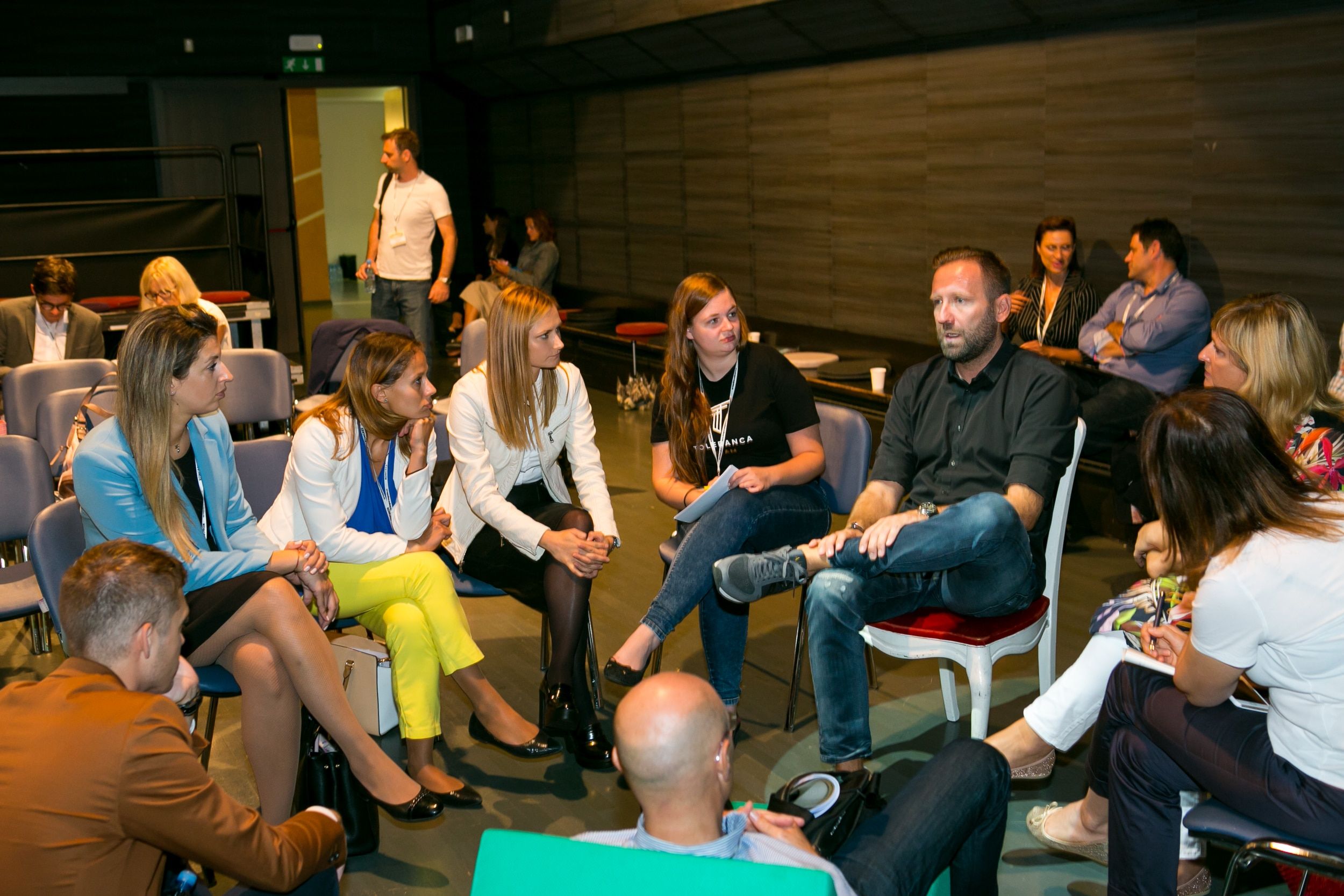
TIPS AND TOOLS
To get the thinking process going, you will find below various possibilities to set up meeting halls. Our starting point is a 50m2 meeting hall without any physical obstacles, able to accommodate 30 to 50 participants. We have prepared various floor plans together with descriptions of their suitability for specific types of events. In practice, various combinations of floor plans are also possible.
BASIC HALL SET-UPS
1. Auditorium / Theatre Style
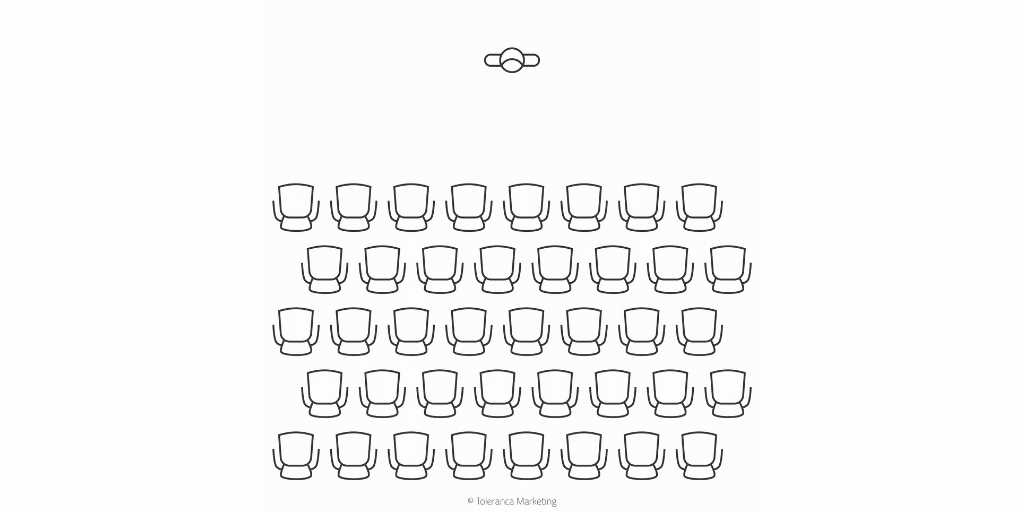
The most classic of all set-ups, the so-called cinema features rows of seats facing the stage.
Positives:
- All participants are focused on what is happening on the stage, the presentation, and the speaker.
- Accommodates the maximum number of participants given the available space.
Negatives:
- The set-up does not allow for interaction between participants.
- Participants are trapped in rows, making entering and exiting the hall difficult.
Suitable for:
Classic frontal lectures which do not require interaction and are attended by a larger number of people.
2. Banquet Style
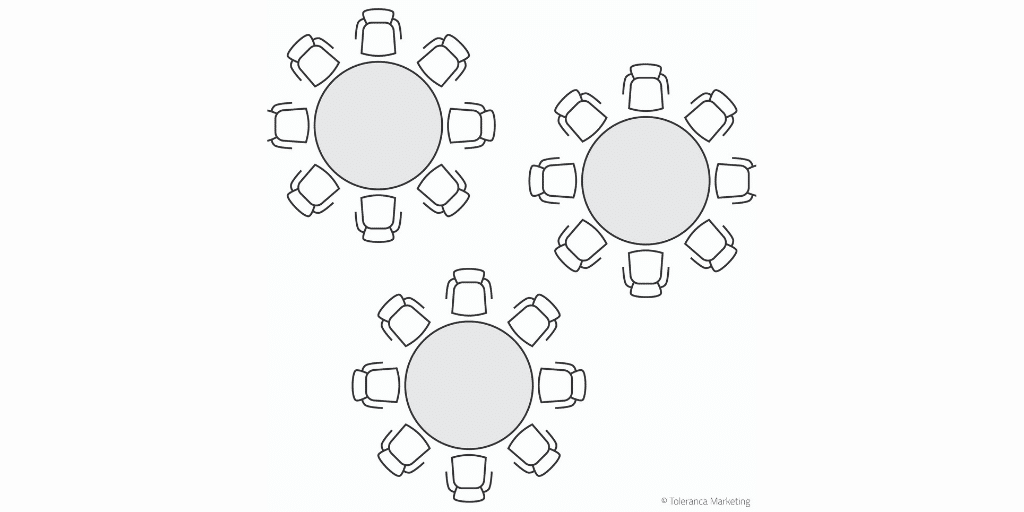
A set-up with round banquet tables for 5 to 12 participants, usually set up for gala receptions.
Positives:
- All participants are focused on what is happening on the stage and the presentation.
- Allows for interaction between participants at the same table.
- Allows for taking notes and serving food and drinks.
Negatives:
- The set-up does not allow for interaction between all participants (only between those seated at the same table).
Suitable for:
Gala dinners, award ceremonies, parties, and educational events where there is a need for discussion in small groups of 5 to 8 participants.
3. Hollow Square Style
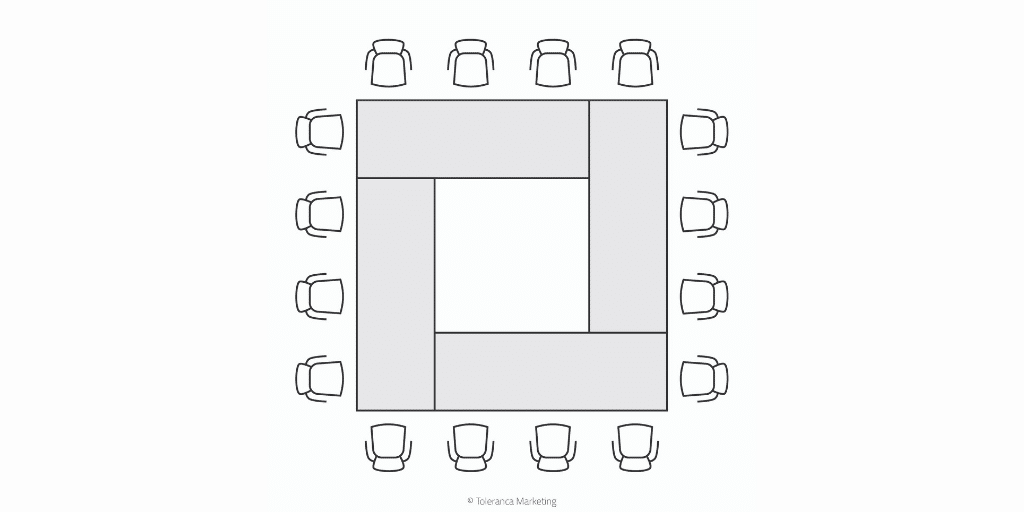
A set-up with tables forming a square used for smaller group events when all participants must be ensured an equal position at the table.
Positives:
- Allows for direct communication between participants, observing the principles of equality.
- Allows for taking notes and serving food and drinks.
Negatives:
- The number of participants is limited.
- Presentations are out of focus and require technical support.
Suitable for:
Events including a smaller number of participants (up to 50), press conferences, roundtables and meetings of ministers.
4. Classroom
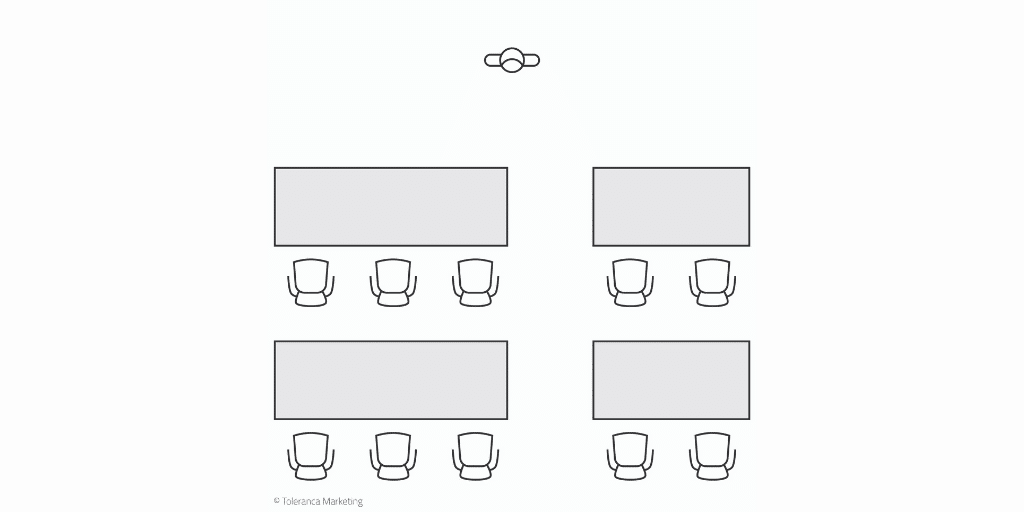
The classic school set-up with tables and chairs which allows for longer and in-depth work and computer use.
Positives:
- All participants are focused on what is happening on the stage and the presentation.
- The participants have the possibility to take notes (table).
- Possibility of serving coffee and snacks.
Negatives:
- Participants are trapped in rows, making entering and exiting the hall difficult.
- Due to tables taking up more space, the hall can host fewer participants.
- Limited interaction between participants.
Suitable for:
Training events, seminars, educational events and product presentations.
5. U-Shape Style

A popular U-shape set-up featuring tables and chairs. Popular because it enables the participants to communicate and provides an open end where the presentation is very visible.
Positives:
- The open end enables the speaker to communicate with participants.
- The participants have the possibility to take notes.
- Allows for communication between participants.
Negatives:
- Due to the set-up structure taking up more space, the hall can host fewer participants.
- The interaction between participants is limited due to the tables.
Suitable for:
Training events, seminars, workshops and motivational events.
6. Horseshoe
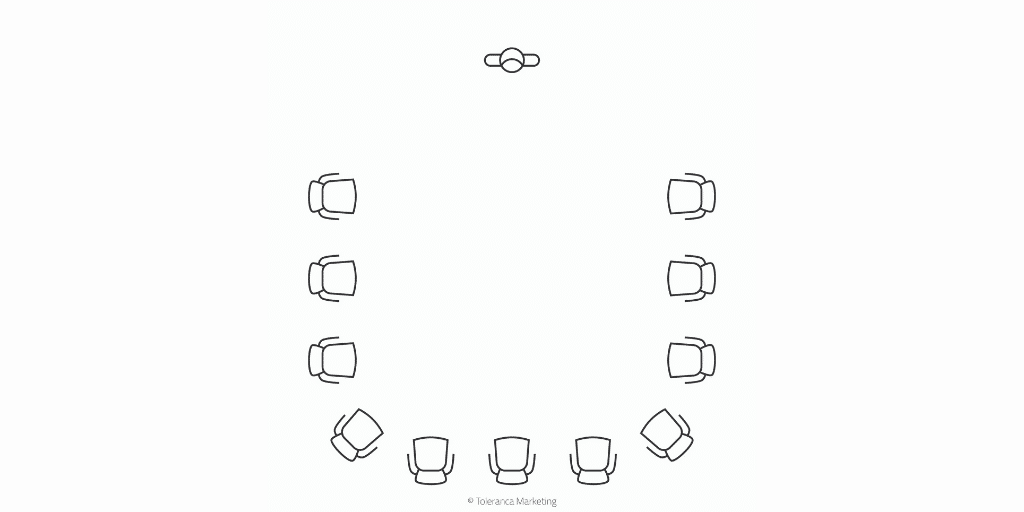
Similar to the U-shape set-up but without tables. Allows for communication between participants and good visibility of presentation.
Positives:
- The open end enables the speaker to communicate with participants.
- The participants have the possibility to take notes.
- Enables communication between participants.
Negatives:
- Due to the set-up structure taking up more space, the hall can host fewer participants.
- Limited interaction between participants.
Suitable for:
Training events, seminars, workshops and motivational events.
7. T-Shape Style
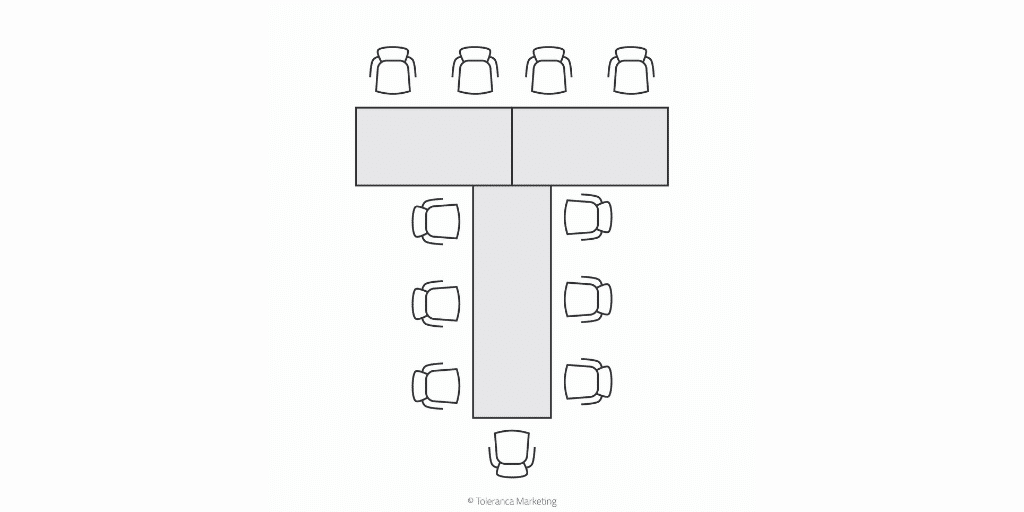
This set-up is suitable for discussions where there’s the main table with the speakers and the part with passive listeners.
Positives:
- All participants can see the speakers and are seated relatively close to them.
- High-quality interaction between participants.
Negatives:
- Due to the set-up structure taking up more space, the hall can host fewer participants.
Suitable for:
Panel discussions, press conferences, and presentations of products involving a smaller number of participants.
8. Herringbone / Chevron

A fishbone set-up which enables participants to be more concentrated on what is happening on the stage and the presentation. A very good use of the space.
Positives:
- All participants are focused on what is happening on the stage.
- The participants have the possibility to take notes.
- Possibility of serving coffee and snacks.
Negatives:
- Participants are trapped in rows, making entering and exiting the hall difficult.
- Limited interaction between participants.
Suitable for:
Training events, seminars, educational events and product presentations.
9. Boardroom
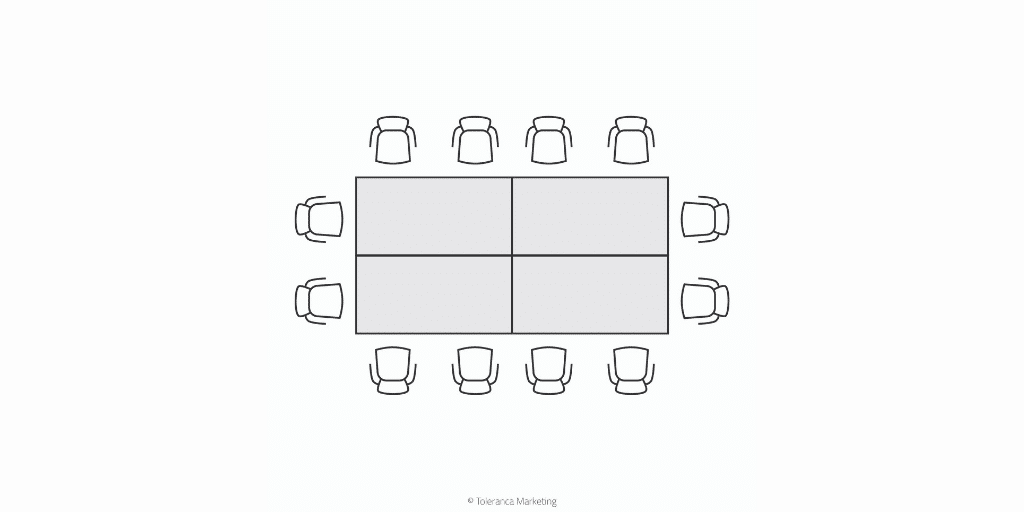
Classic set-up with a table, suitable for smaller groups. Usually used for small-scale business meetings.
Positives:
- Allows for direct communication between participants.
- Allows for taking notes and food and drinks services (table).
Negatives:
- A limited number of participants (due to the large central table).
- Presentation is out of focus.
Suitable for:
Events including a smaller number of participants (up to 40), press conferences, and roundtables.
10. Cabaret
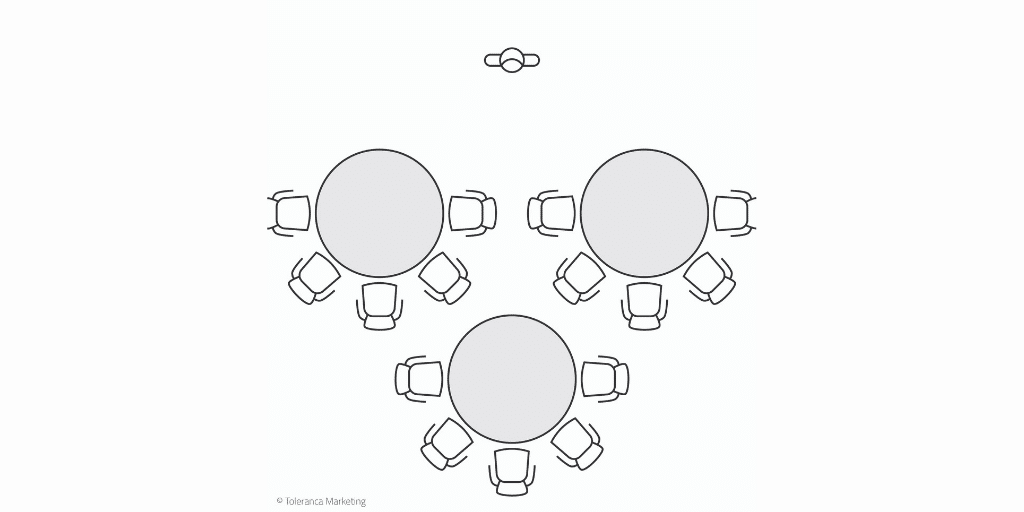
A set-up featuring round banquet tables with an open end (participants only sit at the tables with a direct view of the stage). Mostly used for gala receptions.
Positives:
- All participants are focused on what is happening on the stage and the presentation.
- Allows for interaction between participants at the same table.
Negatives:
- The set-up does not allow for interaction between all participants (only between those seated at the same table).
- A lower number of participants due to fewer chairs at the table.
Suitable for:
Gala dinners, award ceremonies, parties, and educational events where there is a need for discussion in small groups of 5 to 8 participants.
11. Cocktail
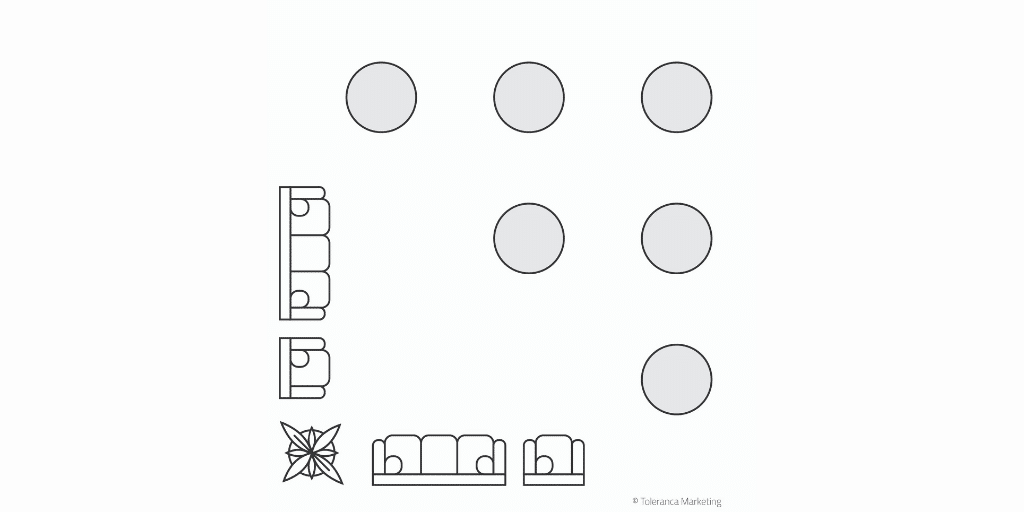
An informal set-up which allows for guests to mingle. A simple set-up, usually involving a stand-up bar where special attention should be devoted to storage areas.
Positives:
- The maximum number of participants given the space available.
- Allows for mingling between participants.
Negatives:
- Participants have no possibility to rest (non-existent rest areas).
- Challenges posed by non-existent storage areas.
Suitable for:
Gala dinners, award ceremonies, parties and informal educational events.
12. Lounge Zone
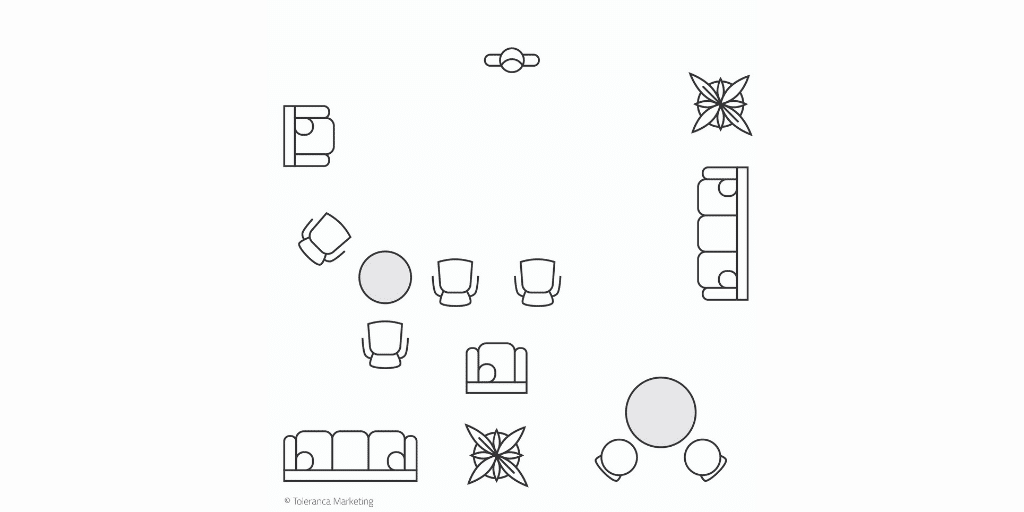
A crossover between classic and creative set-ups. The space is divided into various lounge zones.
Positives:
- Allows for better interaction between participants.
- Allows us to create a special atmosphere.
Negatives:
- An informal set-up of this type is not suitable for all kinds of events.
Suitable for:
Informal conferences and training events.
13. Family Style Seating
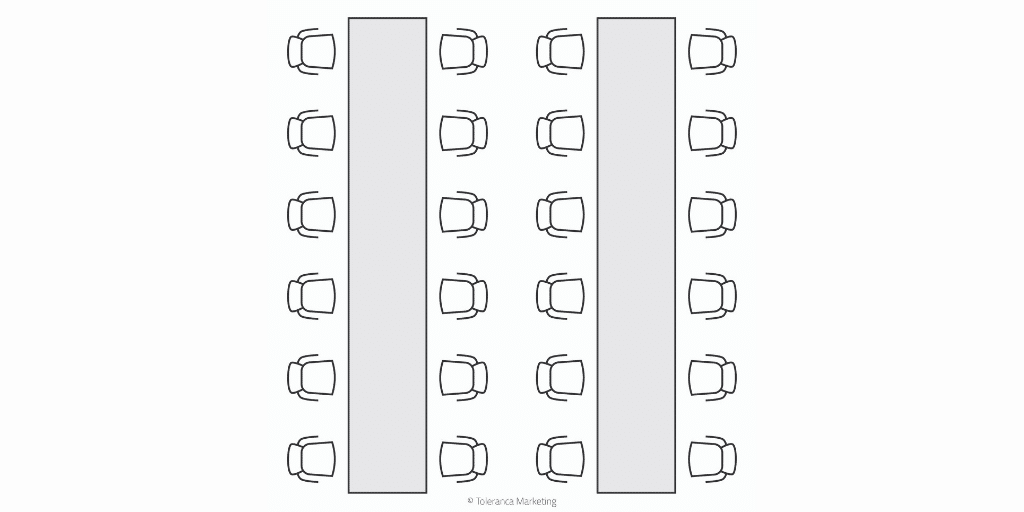
A set-up involving long tables where participants are seated face to face. Often used for receptions and gala events (weddings, award ceremonies).
Positives:
- Allows for efficient use of space.
Negatives:
- Limited passage possibilities between tables.
- Limited communication between participants.
Suitable for:
Working dinners, celebrations, informal events.
14. Runway Seating / Opposing Benches
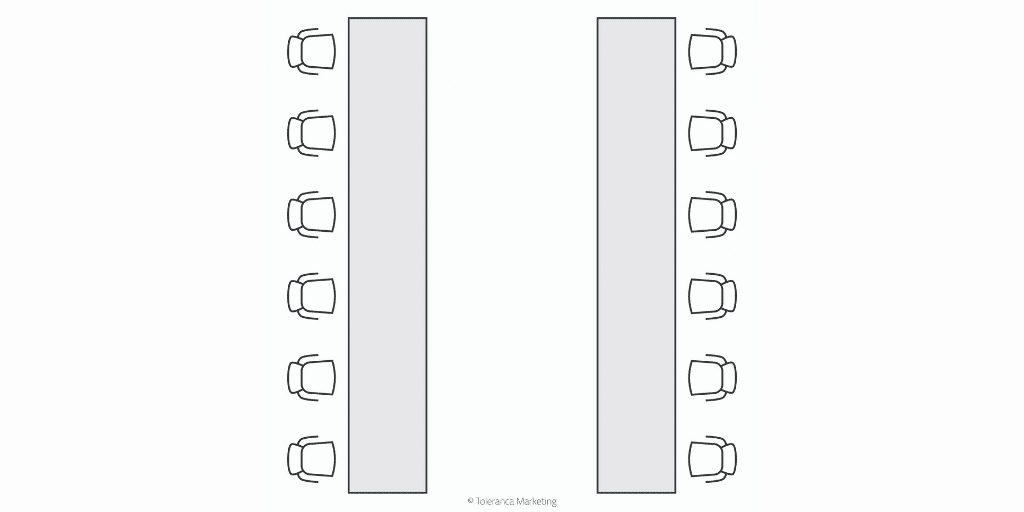
This set-up is typical of fashion shows, where there is a catwalk passing in the middle. The catwalk is not obligatory in this set-up. The focus is put on the speaker and the show.
Positives:
- Allows for good contact with the speaker.
- Allows for relatively good communication between participants.
- The VIP zone can be set up easily.
Negatives:
- It requires a lot of space.
Suitable for:
Corporative presentations, product presentations, concerts, originally intended for runway fashion shows.
CREATIVE HALL SET-UPS
1. Open Space

A contemporary method featuring partially separated, yet open learning units which respond to the specific needs of participants with the aim to foster creativity.
Positives:
- Allows for active participation of participants.
- Allows participants to group according to their interests.
Negatives:
- The set-up requires a lot of space.
Suitable for:
Workshops, seminars, in-depth training events.
2. Trend bar
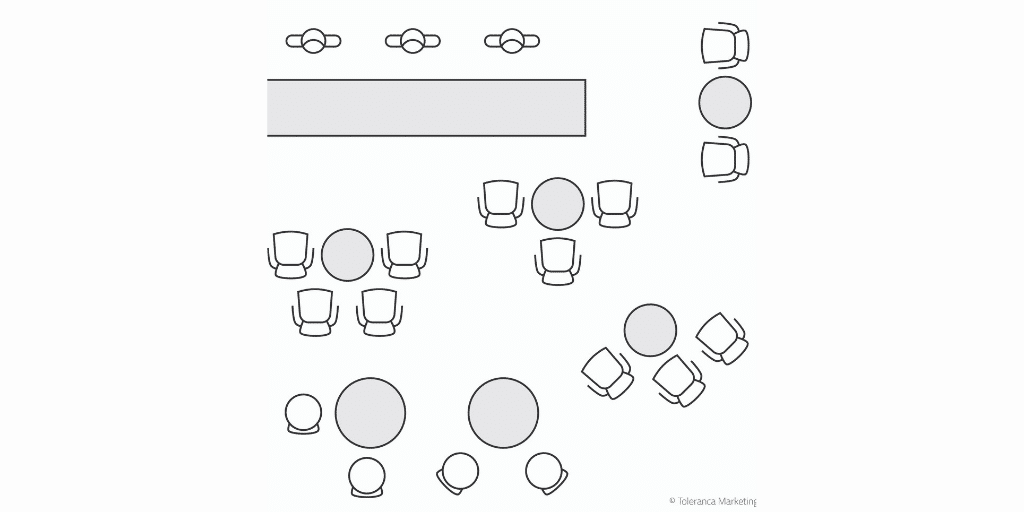
A set-up which resembles a bar and allows for and intimate and deep connection with the content of the event.
Positives:
- All participants are focused on what is happening at the bar and the presentation.
- Allows for interaction between participants at the same bar table.
- Provides for a relaxing atmosphere for the speaker.
Negatives:
- A lower number of participants due to fewer chairs at the table.
Suitable for:
Workshops, seminars, in-depth training events.
3. Boxing Ring
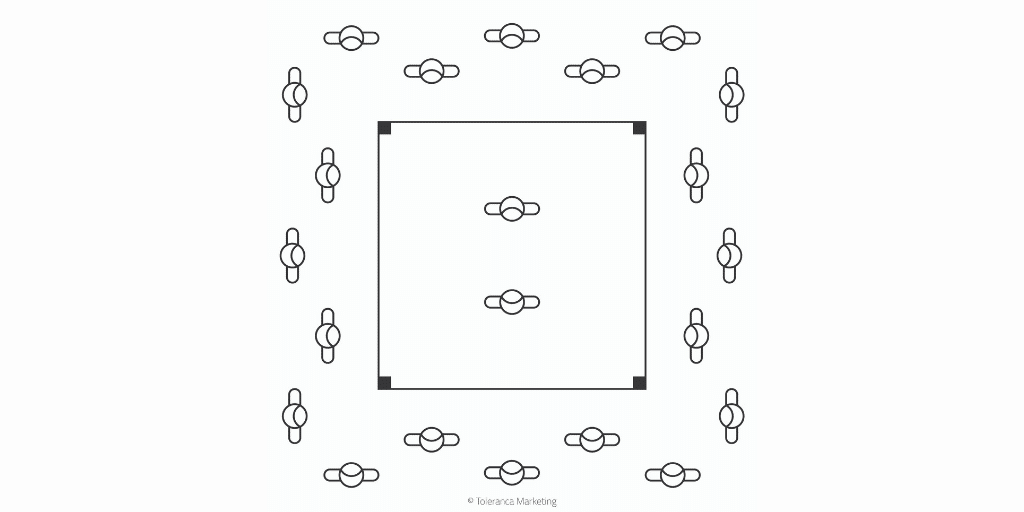
This set-up allows for a duel of opposite opinions (dialogue) and active participation on the part of participants.
Positives:
- All participants are focused on what is happening in the ring.
- Enables role play and identification.
Negatives:
- Harder to control the energy of the audience.
Suitable for:
Discussions, as an alternative to the classic panel discussion.
4. X- Formation
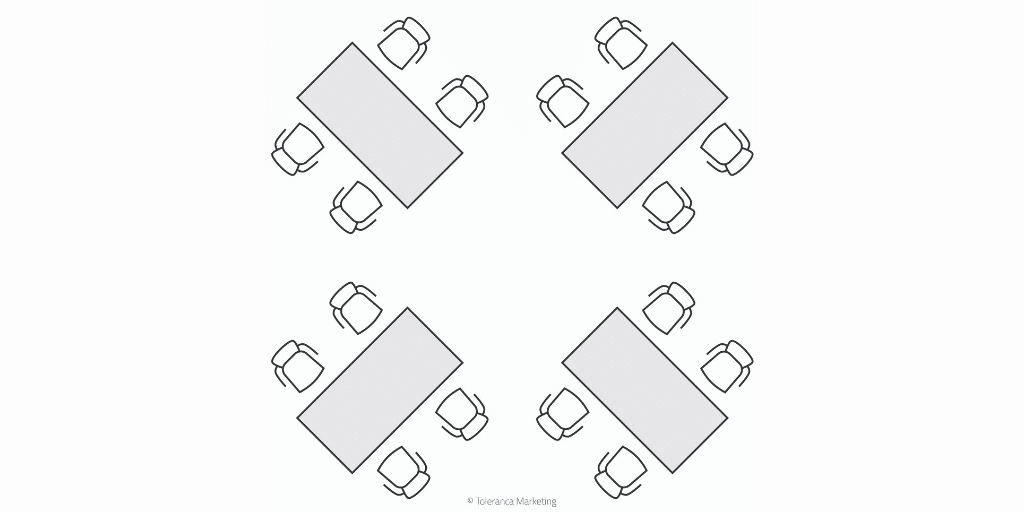
An unusual set-up which originates from weddings and allows for a central stage to be set up.
Positives:
- The central part may be used as a dance floor or performance area.
- Good visibility of the central stage.
Negatives:
- Not very suitable for classic presentations.
Suitable for:
Gala dinners and events, less suitable for conferences.
5. Pod / Cluster
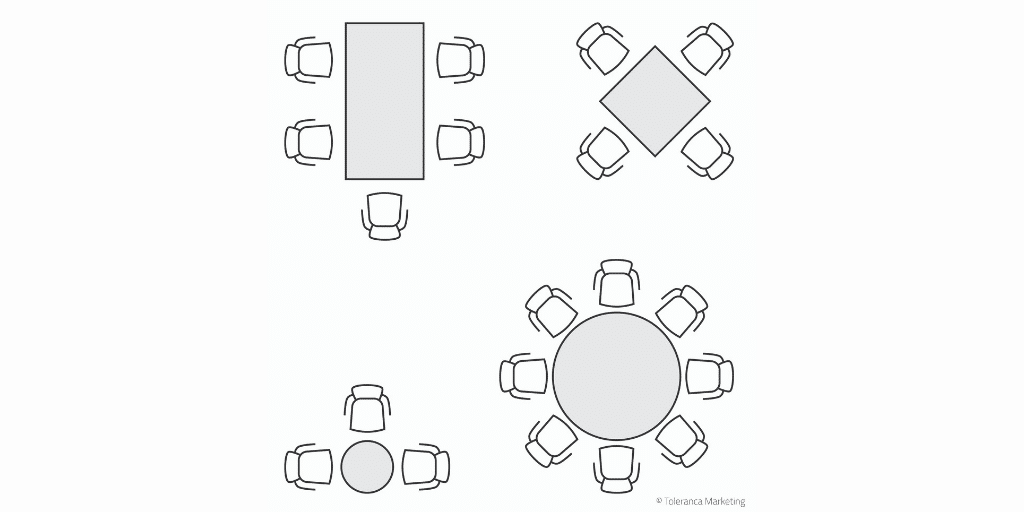
The space is divided into (work) clusters with tables and chairs for group work.
Positives:
- Excellent set-up for working in groups.
- Creates an intimate atmosphere and fosters creativity.
Negatives:
- Suitable for smaller spaces.
Suitable for:
Workshops and group work.
6. Campfire
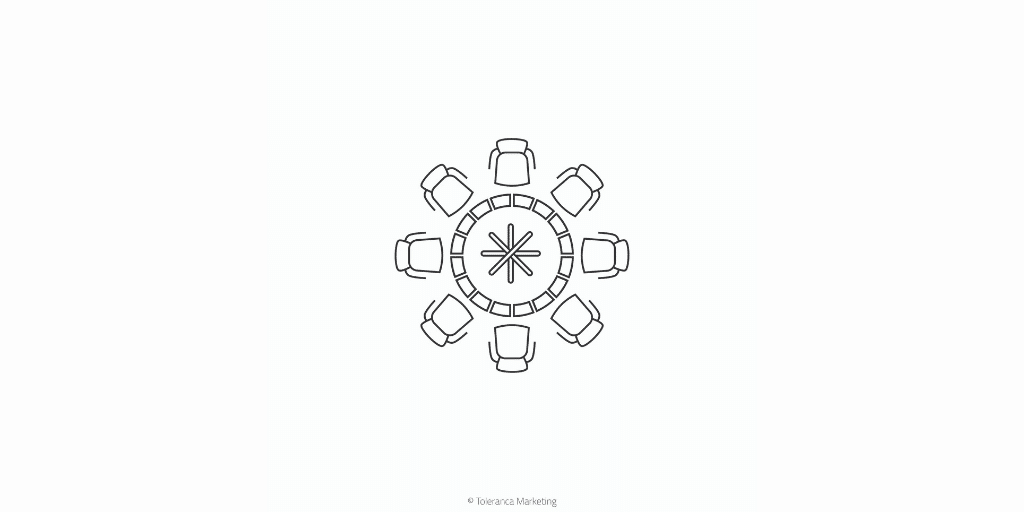
A meeting of a smaller group of participants around a camp fire. The speaker acts as the moderator, shifting the focus onto participants.
Positives:
- Equality between the speaker, moderator, and participants.
- Suitable for introverted participants.
Negatives:
- Small group.
Suitable for:
Brainstorming, transfer of new knowledge, addressing burning issues.
7. War Room / Situation Room
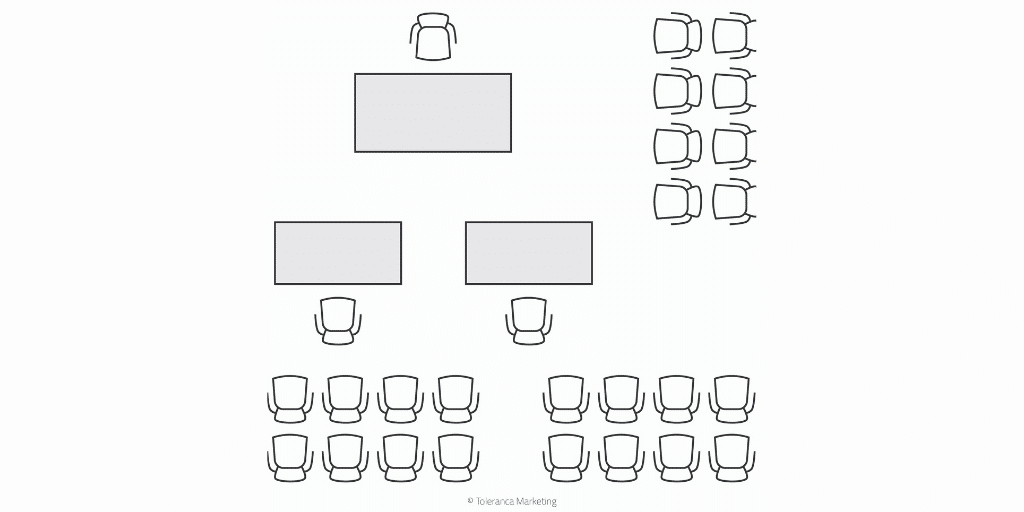
A room adapted for project work featuring large panels for group work, creating canvases, and teamwork.
Positives:
- Allows for visualisation of project ideas.
- Allows for efficient problem solving due to easily accessible data.
Negatives:
- Requires a lot of space.
- Requires solid technical support (boards, pens…)
Suitable for:
Brainstorming, project work, and status reporting.
8. World Café
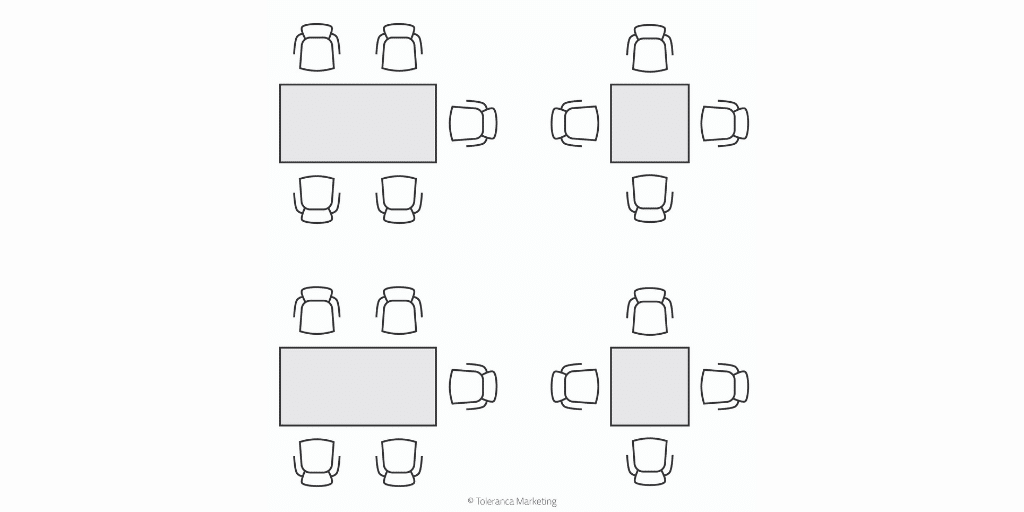
A space arranged as a coffee house. Featuring tables for 4 to 5 participants, each table should be provided with flip charts and similar props.
Positives:
- Creates a pleasant, relaxed environment.
- Allows for collaboration of participants.
Negatives:
- Requires a lot of space.
- Requires solid technical support (boards, pens…)
Suitable for:
Brainstorming, complex training events, and project work.
9. Fishbowl / Samoan Circle
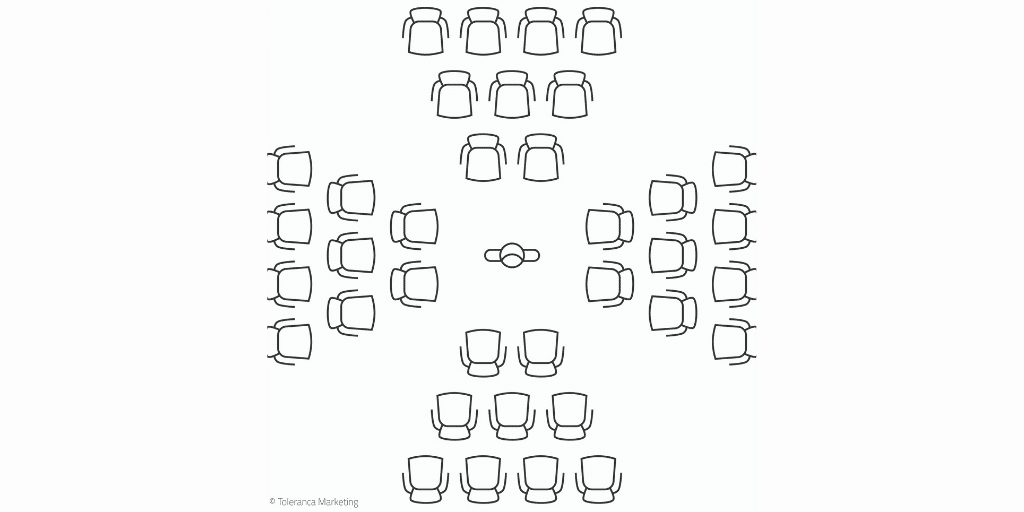
The space features a circular set-up, where the central part is occupied by a discussion table with passages leading towards the central area. This type of set-up is intended for discussion and is a good alternative to panel discussions.
Positives:
- Allows for efficient debate and discussion.
Negatives:
- Requires solid technical support.
- Usually the number of participants is limited.
Suitable for:
Roundtables, panel discussions, conferences addressing specific issues.
10. Hyde Park Corner
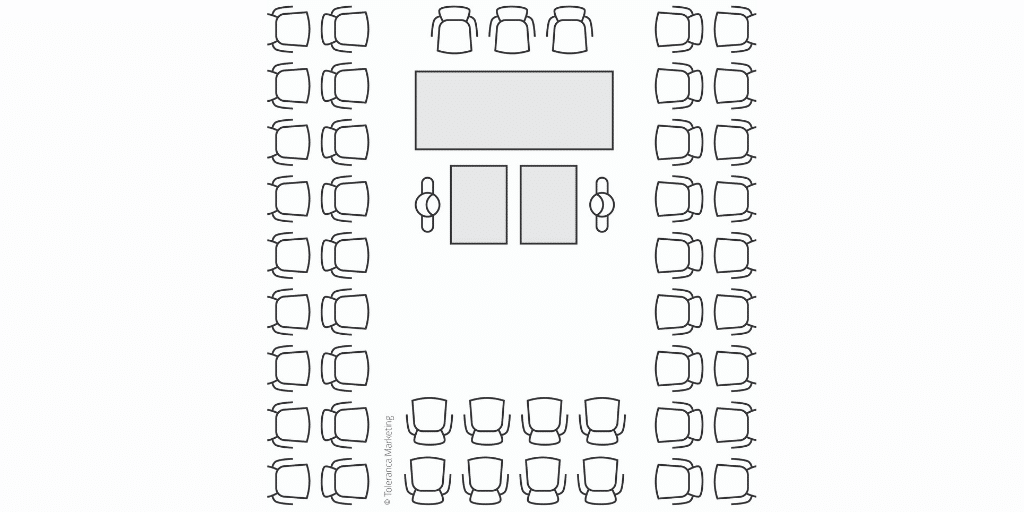
In this case, the space is arranged to resemble the British parliament with two speaker’s stands. Suitable for heated debates.
Positives:
- Allows for efficient debate and discussion.
Negatives:
- Usually, the number of participants is limited.
Suitable for:
Debates and pro et contra discussions.
RECOMMENDATIONS
Do not take the dimensions of the halls published on the interned for granted. Always check the actual size of the space. You will be surprised at how the stated dimensions differ from the actual situation.
Based on our daily practice we have created a list of the five most important recommendations which you should consider when booking a space for your next event.
1. Lack of space
The available area dictates the number of people that you can host at the venue. Pay attention to pillars and similar elements that may reduce the useful area of the hall.
2. Too much furniture
Less is more. Do not overdo it on designer furniture and scenery. It is important to have a good feeling and sense of style.
3. Poor lighting
High-quality lighting is crucial for ensuring the well-being of participants and light comfort. Poor lighting causes tiredness, headaches and nausea.
4. Poor ventilation
Clean and fresh air is vital to the well-being of event participants. We recommend suitable ventilation to keep the air sufficiently humid.
5. Back to nature
Glass surfaces which connect meeting halls with nature provide for greater efficiency.
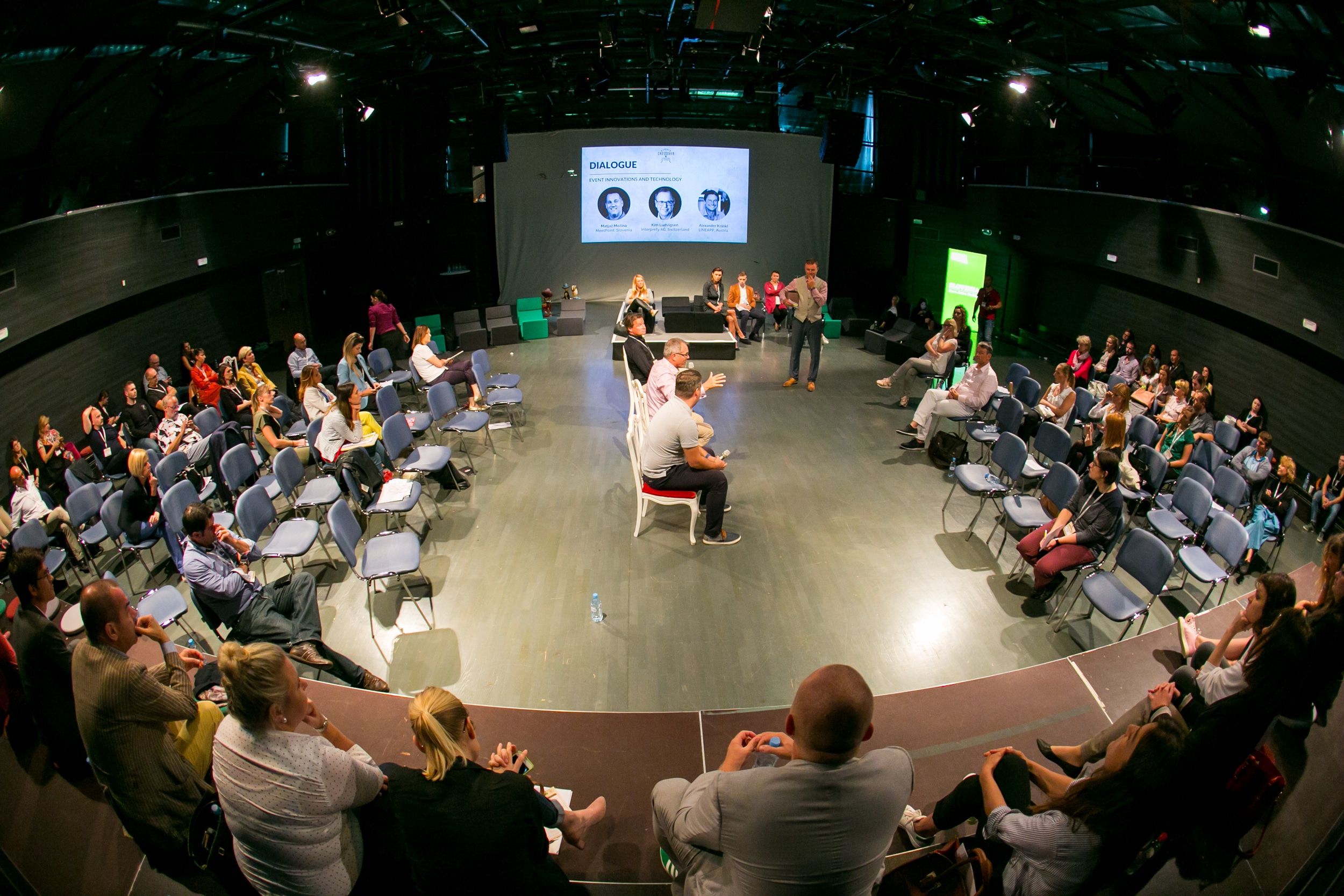
INSPIRATION
CONVENTA CROSSOVER
The idea for this particular event arose from the need to exchange knowledge from the field of event marketing, meeting destinations, and hotels. In addition to providing excellent content, the main idea was to surprise participants with the hall set-up which was reminiscent of the Greek Agora – a public space which allows for informal socialising and in-depth listening. A space which offers all functions of a town square during the entire span of the event. The entire conference is based on a very well thought out customer journey founded on various presentation types and formats.
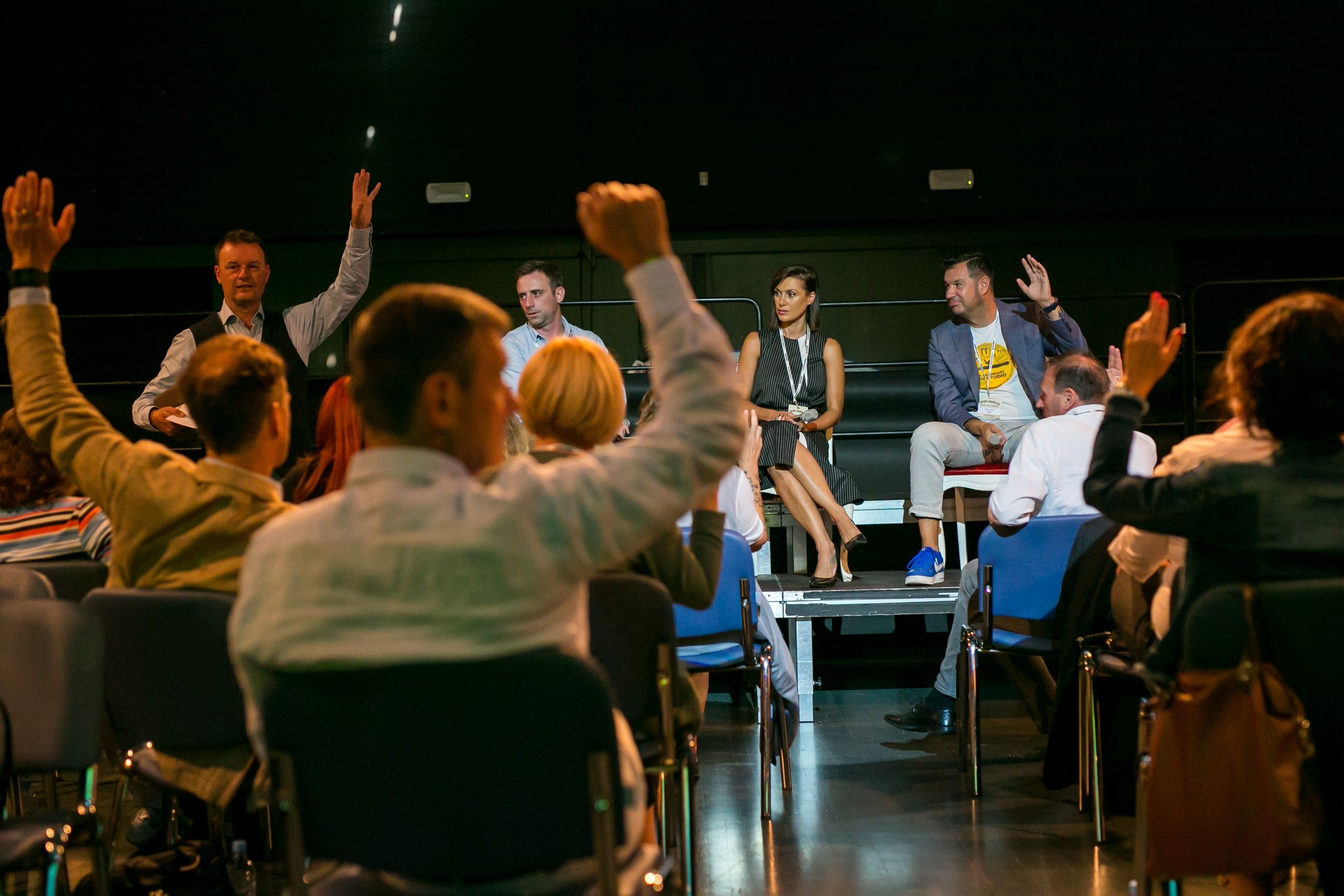
GLOSSARY:
This chapter brings some terms often used by hall providers which you should be familiar with since they may bring additional costs.
Across the Board – an all-inclusive price given, commonly used by many venues and suppliers, that includes all hidden fees such as taxes and gratuities.
Comp Rooms – venue or facility can provide an event planner complimentary rooms (without a charge) based on the number of rooms purchased by a group.
Corkage Charge – a small charge applied for bringing outside alcohol into a venue or facility. The charge is normally made per bottle.
Cut-Off Date – this date refers to when a facility releases a block of rooms or space.
Incidentals – refers to minor or miscellaneous expenses, other than room and tax rates, that are billed to a guest’s account in a hotel
Rack Rate – this is the standard rate for a hotel room without discounts, which is often the highest rate published.


